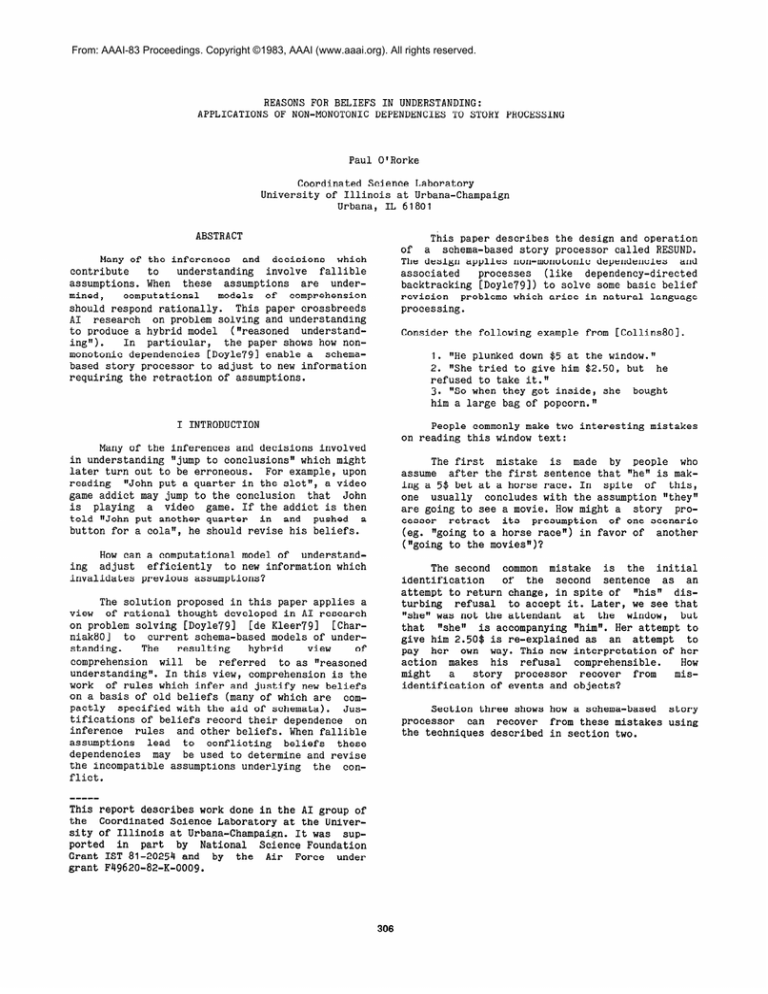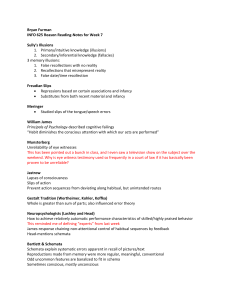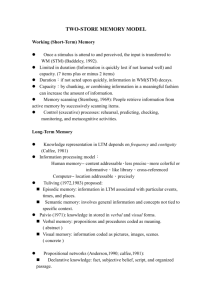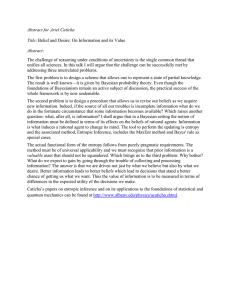
From: AAAI-83 Proceedings. Copyright ©1983, AAAI (www.aaai.org). All rights reserved.
REASONS FOR BELIEFS IN UNDERSTANDING:
APPLICATIONS OF NON-MONOTONIC DEPENDENCIES TO STORY PROCESSING
Paul O'Rorke
Coordinated Science Laboratory
University of Illinois at Urbana-Champaign
Urbana, IL 61801
ABSTRACT
This paper describes the design and operation
of a schema-based story processor called RESUND.
The design applies non-monotonic dependencies and
associated
processes (like dependency-directed
backtracking [Doyle79]) to solve some basic belief
revision problems which arise in natural language
processing.
Many of the inferences and decisions which
understanding involve fallible
contribute
to
assumptions. When these assumptions are undermined,
computational models of comprehension
should respond rationally. This paper crossbreeds
AI research on problem solving and understanding
to produce a hybrid model ("reasoned understanding").
In particular, the paper shows how nonmonotonic dependencies [Doyle791 enable a schemabased story processor to adjust to new information
requiring the retraction of assumptions.
Consider the following example from CCollins801.
1. "He plunked down $5 at the window."
2. V'Shetried to give him $2.50, but he
refused to take it."
3. "So when they got inside, she
him a large bag of popcorn.n
I INTRODUCTION
bought
People commonly make two interesting mistakes
on reading this window text:
Many of the inferences and decisions involved
in understanding 'jump to conclusions" which might
later turn out to be erroneous. For example, upon
reading "John put a quarter in the slot", a video
game addict may jump to the conclusion that John
is playing a video game. If the addict is then
told "John put another quarter in and pushed a
button for a cola", he should revise his beliefs.
The first mistake is made by people who
assume after the first sentence that "hen is making a 5$ bet at a horse race. In spite of this,
one usually concludes with the assumption Ithey"
are going to see a movie. How might a story processor retract its presumption of one scenario
(eg. "going to a horse race") in favor of another
(ngoing to the movies")?
How can a computational model of understanding adjust efficiently to new information which
invalidates previous assumptions?
The second common mistake is the initial
identification of the second sentence as an
attempt to return change, in spite of nhisn disturbing refusal to accept it. Later, we see that
'Ishenwas not the attendant at the window, but
that nshe" is accompanying "him". Her attempt to
give him 2.50$ is re-explained as an attempt to
pay her own way. This new interpretation of her
action makes his refusal comprehensible. How
mismight
a
story processor recover from
identification of events and objects?
The solution proposed in this paper applies a
view of rational thought developed in AI research
on problem solving [Doyle791 [de Kleer791 [Charniak80] to current schema-based models of underview
of
standing.
The
resulting hybrid
comprehension will be referred to as "reasoned
understanding". In this view, comprehension is the
work of rules which infer and justify new beliefs
on a basis of old beliefs (many of which are compactly specified with the aid of schemata). Justifications of beliefs record their dependence on
inference rules and other beliefs. When fallible
assumptions lead to conflicting beliefs these
dependencies may be used to determine and revise
the incompatible assumptions underlying the conflict.
Section three shows how a schema-based story
processor can recover from these mistakes using
the techniques described in section two.
--weThis report describes work done in the AI group of
the Coordinated Science Laboratory at the University of Illinois at Urbana-Champaign. It was supported in part by National Science Foundation
Grant IST 81-20254 and by the Air Force under
grant F49620-82-K-0009.
306
John recieved some tickets from someone) are
inferred by elaboration. Intentionality rules generate intentional explanations similar to those
constructed by PAM [Wilensky811 using the information about goals and methods supplied by schemata.
When two descriptions appear to refer to the same
event or object, RESUND's identification inference
rules make the assumption that the descriptions
are co-referential. Bottom up schema invocation is
also treated as a presumptive inference in RESUND
induced schema
(called criteriality). Event
activation is the simplest kind of criteriality
assumption. This happens when a sub-event of a
complex event causes RESUND to assume the complex
event occured (as when "She bought popcornn sugmovies")
CSchank771
gests "she went to the
CDeJong791.
II DEPENDENCIES IN UNDERSTANDING
view
of
understanding is
a
Reasoned
comprehension inspired by AI research on problem
solving and decision making CDoyle801. It inherits the notion that attitudes (eg. beliefs) are
the
state
of
the important indicators of
comprehension. In fact, understanding is viewed as
a process of transition from one set of "current"
attitudes to another. Furthermore, justifications
for attitudes play a key role in determining which
For example, reasons
ones are currently held.
supporting possible beliefs not only determine
which ones are currently believed, but also provide the basis for inferring new beliefs and
This section sketches the
retracting old ones.
design and operation of a schema-based story processor (called RESUND) compatible with reasoned
understanding. The story processor is still under
construction at the time of this writing.
AI natural language processing systems are
bound to make mistakes like those made by people
reading the window text. RESUND recognizes mistakes which reveal themselves in the confusion of
conflicting beliefs. The most common conflicts in
the examples studied to date have been identity
conflicts and other violations of schematic constraints or defaults. Identity conflicts arise
when two objects or events are assumed to be
identical and
not
identical simultaneously.
Schematic constraint violations occur when a restriction on variables or other schemata associated
with a given schema is broken. When such conflicts
arise, a process like dependency-directed backtracking determines the underlying incompatible
assumptions by looking back along dependencies.
Unfortunately, in natural language processing, it
wouldn't do to just arbitrarily rule out one of
these assumptions in order to resolve the conflict. Thus, RESUND requires a method to decide
which assumption should be revoked (which assumption is weakest).
The "knowledge base" of the story processor
is organized into bundles of assertions called
schemata. A schema intended to capture knowledge
about an event includes variables for objects
which play roles in the event and a list of associated schemata. Relationships between the associated schemata include primitive temporal and
causal links. Top down script elaboration inferences (a la SAM) CCullingford811 are supported by
a special elaboration relation which specifies the
consequences of belief in an assertion that an
event has occurred. Construction of intentional
explanations (a la PAM) CWilensky811 is supported
by associations such as X is an aim (goal) of Y
and X is a method for achieving Y. In addition,
schemata specify constraints and default values
for their role variables.
A crucial point about inferences in understanding is that they are often presumptive. They
generate beliefs not just by logical deduction,
but also by making assumptions of various kinds.
The main difference between RESUND and previous
story processors is that RESUND uses non-monotonic
dependencies to compensate for the fact that its
inference processes are fallible. A collection of
inference rules (a la AMORD) [de Kleer791 generate
and justify new assertions representing beliefs.
Some inference mechanisms which contribute to the
construction of explanations of sequences of input
events are elaboration, intentionality, identification and criteriality.
The current design calls for a collection of
preference policies which represent different criteria for gauging the relative strength of incompatible assumptions. Some of these policies implement text comprehension principles and problem
solving strategies reported in [Collins801 and
[Wilensky83]. Another class of policies is based
on RESUND's taxonomy of inferences and the notion
that some assumptions made in natural language
processing are inherently weaker (more fallible)
than others. These policies prefer constraints and
elaboration inferences over defaults and see idencriteriality
tification, intentionality, and
assumptions as the most likely losers in a conflict. Unfortunately, several preference policies
may be applicable to a given conflict. The current
design calls for the simplest possible conflict
resolution: a total order on the preference policies. When several are applicable, the strongest
one is allowed to choose the weakest assumption.
Elaboration rules expand the definitions of
complex concepts in schemata to capture inferences
similar to SAM's [Cullingford
top down script
applications. For example, when RESUND "comes to
believen that a complex event has taken place,
leg. John purchased some tickets from someone),
the definitional consequences (John paid someone,
307
III EXAMPLES
Al. The purchase of refreshments by a
member of the PARTY attending the movie
= "she bought popcorn.n
A2. The return of change by the TICKETBOOTH-ATTENDANT = "she gave $2.50."
handle
miswill
To see
how
RESUND
identification, consider the following simplified
variant of the window text.
There is no alternative to identification Al in
the "going to the movies" schema, but A2 does have
an alternative: members of PARTY sometimes repay
(or prepay) the BUYER who purchases the group's
tickets. For this reason, A2 is considered weaker
than Al, and the constraint violation conflict is
resolved by ruling A2 out.
Mis-identification Example.
1. He put down
$5 at the Thunderbird
theatre ticket window.
2. She gave him $2.50.
3. When they got inside, she bought herself a bag of popcorn.
Next, consider an example of the
mis-activation of schemata.
The first sentence invokes a schema about "going
movies." Elaboration of this action
to
the
includes
includes "purchasing tickets," which
"paying for the tickets," and the "return of
change" (if any). The placement of $5 at the
ticket window is identified as part of npayingn
for some tickets. This means "hew is the BUYER of
tickets, a member of the PARTY "going to the
movies". By convention, the roles in this and
other schemata will be in upper case.
problem
of
Mis-activation Example.
1. John put two quarters in the slot.
2. Then he started his first game.
If you originally thought John was going to
get a cola from a vending machine, as he did
earlier in the paper, then you had to retract this
assumption with any conclusions founded on it.
This example, like the horse-races to movies
switch, is just about the simplest kind of misactivation.
The action in the second sentence is identified as the "return of change". This isn't the
action,
the
only possible identification of
because there are several other transfers of money
None of
associated with ngoing to the movies".
the other identifications is compatible with this
one, and at this point "return of change" is preferred because it is contained in the schema
describing "buying tickets", as was the initial
transfer of payment. This action identification
implies two new role identifications: she is the
the $2.50 is his
TICKET-BOOTH-ATTENDANT and
CHANGE.
We have worked out dependencies for event
induced schema activation which enable RESUND to
recover from this sort of mistake:
The insertion of quarters in a slot is an
action which invokes the wcoke machine" and "video
game" schemata by
event
induced
activation
LDeJong791 Elaborations of these schemata include
corresponding insertions of change, as well as
inferences about what will happen next, etc. An
identity conflict arises because the insertion of
change in the coke machine schema is incompatible
with the insertion in the video game schema, (if
they are not compatible, they cannot both be
identical to the input
Dependencyevent).
directed backtracking determines that one of the
schema invocations must be retracted.
A preference policy decides to retract video-game on very
weak grounds, perhaps because the last time the
system saw this sentence, "coke machine" turned
out to be the right schema.
Both actions in the third sentence are identified as actions of members of the PARTY going to
the movie, (namely "entering the theater" and
"purchasing refreshments"). Thus, "she" is seen to
be a moviegoer. This violates a schematic constraint on TICKET-BOOTH-ATTENDANTwhich reflects
the fact that normally, the attendant is not a
member of one's party when one goes to the movies.
Whether this constraint is learned by experience or derived from more basic constraints,
recognition of the constraint violation triggers
dependency-directed
backtracking.
Datadependencies associated with the
inconsistent
beliefs
(TICKET-BOOTH-ATTENDANT in PARTY, not
TICKET-BOOTH-ATTENDANTin PARTY) and their ancestors are examined to determine the assumptions
underlying the conflict. The belief that the
ATTENDANT should not be in PARTY is strong because
it is based on constraints in the wgoing to the
movies" schema.
The belief that ATTENDANT is in
PARTY depends on she = ATTENDANT and she in PARTY.
Ultimately, the conflict depends on the following
identification assumptions.
The second sentence contains an event which
is identified as part of the dead nvideo-gamew
schema. The fact that there is no alternative
identification is seen as an argument against the
weak decision to rule out the video game scenario.
The original contradiction comes back in, but now
there is a strong reason to prefer nvideo-gamen
over wcoke-machinew: namely that it explains more
input events.
308
[Cullingford
IV CONCLUSION
R. Cullingford, "SAM," in Inside
Understu
:
Jz.uLc
This paper argues that better models of
understanding can be constructed by applying views
and techniques originally developed in AI research
on problem solving. In particular, nearly all
current story processors have no reasons for their
beliefs; so when they make inferences and decisions which jump to false conclusions, they have
no
recourse to reasoned retraction. ARTHUR,
MCARTHUR, and JUDGE are exceptional, in that they
attempt
to
recover
from
inference
errors
CGranger801 CGranger821. However, they appear to
concentrate exclusively on revision of intentional
explanations, and
do
not
appear
to
use
dependency-network-maintenance techniques to supplant incorrect explanations.
Lawrence
Erlbaum
Associates,
Hillsdale, N.J., 1981, 75-119.
[de Kleer791
J. de Kleer, J. Doyle, G. L. Steele
and
G.
J.
Sussman, "Explicit
Control
of
Reasoning,n
'
. . .
Pe SD ctive, vol. 1, P.H. Winston
an: E.H. Brown (ed.), MIT Press,
Cambridge, Massachussetts, 1979,
33-92
The usefulness of reasoned understanding as
part of a model of human comprehension is limited
by the fact that it ignores affect and emotion. In
addition, we have only described a handful of
belief revision methods and they are so simple
that people usually do them unconsciously.
l
CDeJong791
G. F. DeJong, "Skimming Stories in
Real
Time:
An
Experiment in
Integrated Understanding," 158,
Yale
University Dept. of Comp.
Sci., New Haven, Conn., May 1979.
[Doyle791
J. Doyle, "A Truth
Maintenance
. .
System,w Art1 iclal J ntelliaence
Xi,, (1979),
Nevertheless, we expect non-monotonic dependency networks and associated processes (like
dependency-directed backtracking) to
become
integral
parts of future applied AI natural
language processing systems. In an effort to help
make this happen, we have begun implementing
RESUND. The design incorporates schemata and an
inference taxonomy derived from a schema-based
story processor constructed in the summer of 1982.
We have worked out detailed dependencies and
preference policies which seem necessary
for
several examples like those presented in section
III. When the implementation is complete we will
run experiments to verify that the design works as
planned. We expect future experiments to lead to
the discovery of new types of inference and new
preference policies, if not to radical changes in
the design of the story processor.
[Doyle801
J.
Doyle,
"A
Model
for
Deliberation,
and
Action,
Introspection,w
Artificial
Intelligence Technical Report-581,
MIT Artificial Intelligence Lab.,
Cambridge, MA, May, 1980.
CGranger801
R.
H.
Granger,
"Adaptive
Understanding: Correcting Erroneous
Inferences," 171) Yale Univ. Dept.
of Comp. Sci., New Haven, Conn.,
January 1980.
CGranger821
R.
H.
Granger,
"Judgemental
Inference: A Theory of Inferential
Decision-Making
During
Understanding,IIProc. ti -Fourth
Annual Conf. af
&&
Cognitive
,Science a,
Ann Arbor, MI,
ACKNOWLEDGEMENTS
1982,
My sincere thanks to G. DeJong, M. Dorfman,
C. Debrunner and the other reviewers of this
paper.
2,;f2,2.
177-180.
CSchank771
R. Schank and R. Abelson, Scrints,
PlZ,
Goals and Understanding: &
Inauirv
&&Q
Human
gn0wJedge
Structures,
Lawrence
Erlbaum,
Hillside, NJ, 1977.
CWilensky811
R. Wilensky, "PAM,"
in
Inside
Comnuter
Understanding:
Jlzias
Progr ms Plus
Miniature
Sohanka and C.K. Riesbec:' (e,":y:
Lawrence
Erlbaum
Associates,
Hillsdale, N.J., 1981, 136-179.
CWilensky831
R.
Wilensky,
Eknnim
Understanding:
mutational
Reasoning
Lbmxcm&
LQ
mk?iik
Addison-Wesley, Reading,
Mass.:
REFERENCES
[Charniak80]
E. Charniak, C. Riesbeck and D.
McDermott, "Data Dependencies," in
Artificial
s
Lawrence
Erlbaum
ProQ-mmin@;
Assooiates,'Hillsdale,N.J., 1980,
[Collins801
A. Collins, J. S. Brown and K. M.
Larkin,
nInference
in
Text
Understanding," in
IheoreticaL
Issues .& Reading Comnwsion,
R.J. Spiro, B.C. Bruce, and W.F.
Brewer
led.), Lawrence Erlbaum
Associates, Hillsdale, N.J., 1980,
193-226.
1983.
385-407.
309







